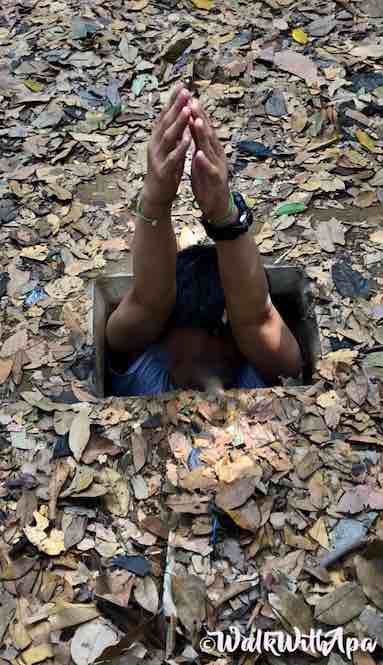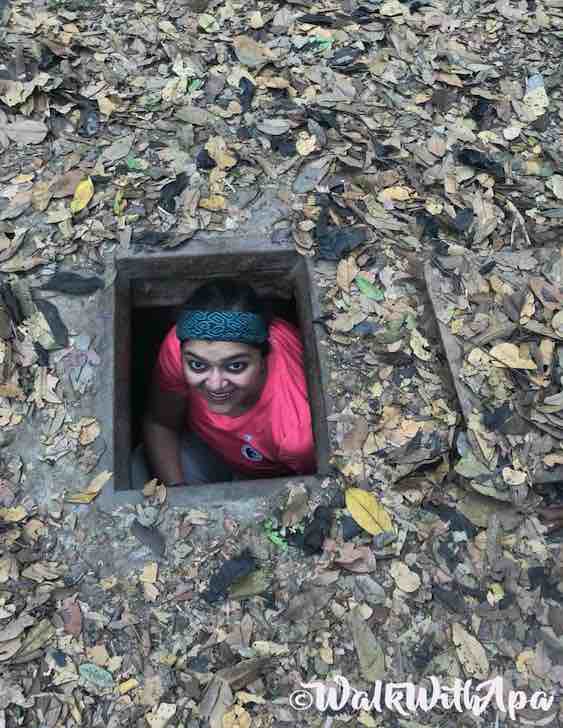The tunnels at Củ Chi are a popular tourist attraction today, but they once housed people during war. These tunnels are part of a network that ran from Saigon to the Cambodian border. The tunnels in the Củ Chi district alone are estimated to be about 250km. Currently, visitors can visit a very small segment of the tunnels at Củ Chi to get a glimpse of hidden past. My experience at Ben Douc, Cu Chi tunnels was nothing but humbling.
History of the Tunnels
The digging of the tunnels started in late 1940s, during the war against the French. In the course of the Vietnam War, these tunnels were expanded and served as a base for North Vietnam or Viet Cong. The tunnels are multi-storeyed, and house several rooms for living, storing, strategizing and even cooking. The tunnels and areas around included several traps. The entrances were camouflaged, and tunnels were made small enough to only fit the small-statured Vietnamese. This strategic construction helped them keep the American army away. The tunnels also protected the Viet Cong from explosives dropped from bomber planes. Life in the tunnels was not easy. There was not only a shortage of supplies but also issues with pests and diseases.

Getting to the Tunnels
Củ Chi Tunnel system is divided into two sites – Ben Douc and Ben Dinh. The Ben Dinh site has restructured portions of the tunnels and is more popular among groups tours. To get a more authentic experience and avoid the tourist hoards, I chose to visit the Ben Douc site. To make it even more appealing I chose to take the city bus to get to the tunnels.
A number of group and private tours are available to the Ben Dinh site of Củ Chi tunnels. You can easily get to the Ben Douc by public bus. Since I ran into one group out there, I think it is possible to find a tour to Ben Douc.
The site looked very deserted as we approached the ticket counter. The ticket costs 90000VND (~4USD) and includes a mandatory guide. There are a few exhibits and war relics at the entrance. Upon forming small groups of about 20 people a guide is assigned at the entrance. The guide helps you find the entrances to the tunnels, while talking about life during the war.

Camouflaged Tunnel Entrance 
Our Guide Uncovering the Tunnel Entrance
Experience in the Ben Douc tunnels
We were given the option of going into four tunnels. The first two are not too long and comfortable to navigate. These can serve as a test to decide if you want to enter the remaining two. The first one was only 5m long and the second was a well-ventilated room. The third tunnel entrance was so small that I had to put my hands up to enter and exit it.
The final tunnel was what gave me the closest experience of life underground. After an initial 15m passage we entered a strategy bunker. From here one has the option to go back up or continue another 50m. I chose the latter. This passage is extremely narrow, and I had to be on all fours to crawl my way out. Though there is a source of light, due to it being narrow and the people in front of you it gets very dark. Thankfully, if not for the people in front of and behind me, I would have panicked. If you experience any discomfort in the first few tunnels, I would recommend skipping the last one.
At the end of the tour, you can try eating what the Viet Cong ate – tapioca and crushed peanuts. After viewing models of some of the traps used during the war, you enter a souvenir shop. Here, you have the option of firing a rifle at the range. I chose to forego that and instead walked around the site.

A friend entering the tunnel 
Apa inside a tunnel at Ben Douc
Final Thoughts
Entering the tunnels at Củ Chi will always be one of the most humbling experiences in my life. Walking; practically crawling through some of these tunnels makes one wonder about the reality of war. Going down tiny entrances, making your way through dark, the lack of oxygen and the heat made me want to get out of the 50m tunnel almost immediately. Human survival instinct is almost a miracle! I couldn’t imagine living under the ground for a few of minutes, let alone a few years. This long network of tunnels is a reminder of Vietnam’s grim past and also serves as a warning against war.
Visited: Mar 2019






Wow! Such a well written article. Made me want to go there and see for myself!
Great experience